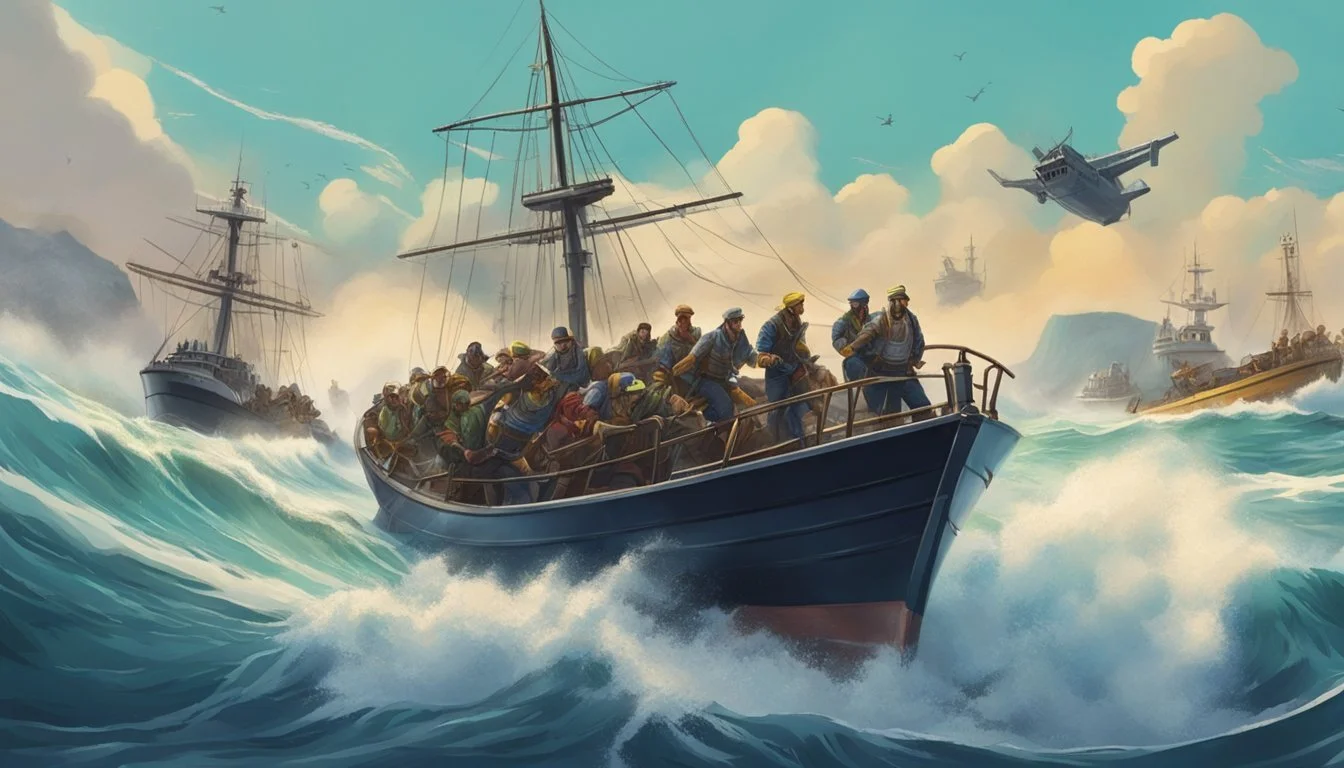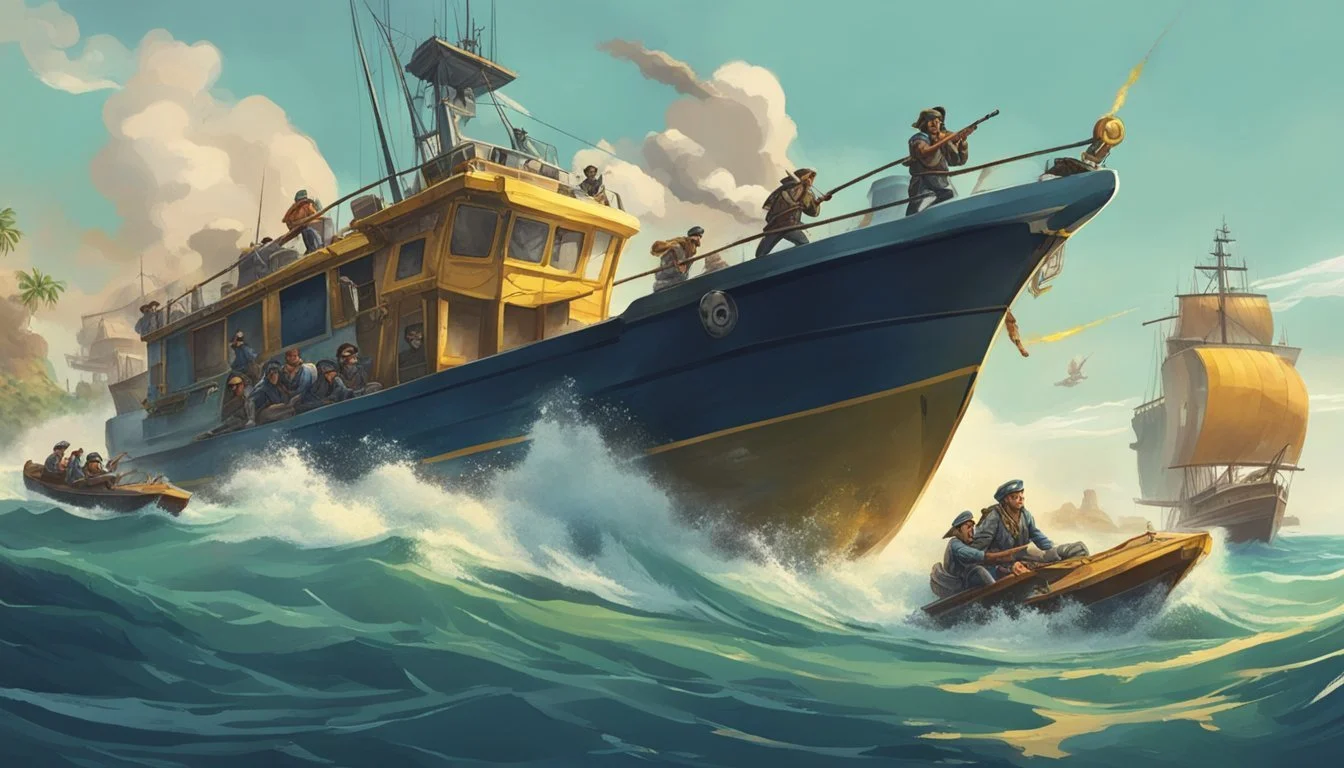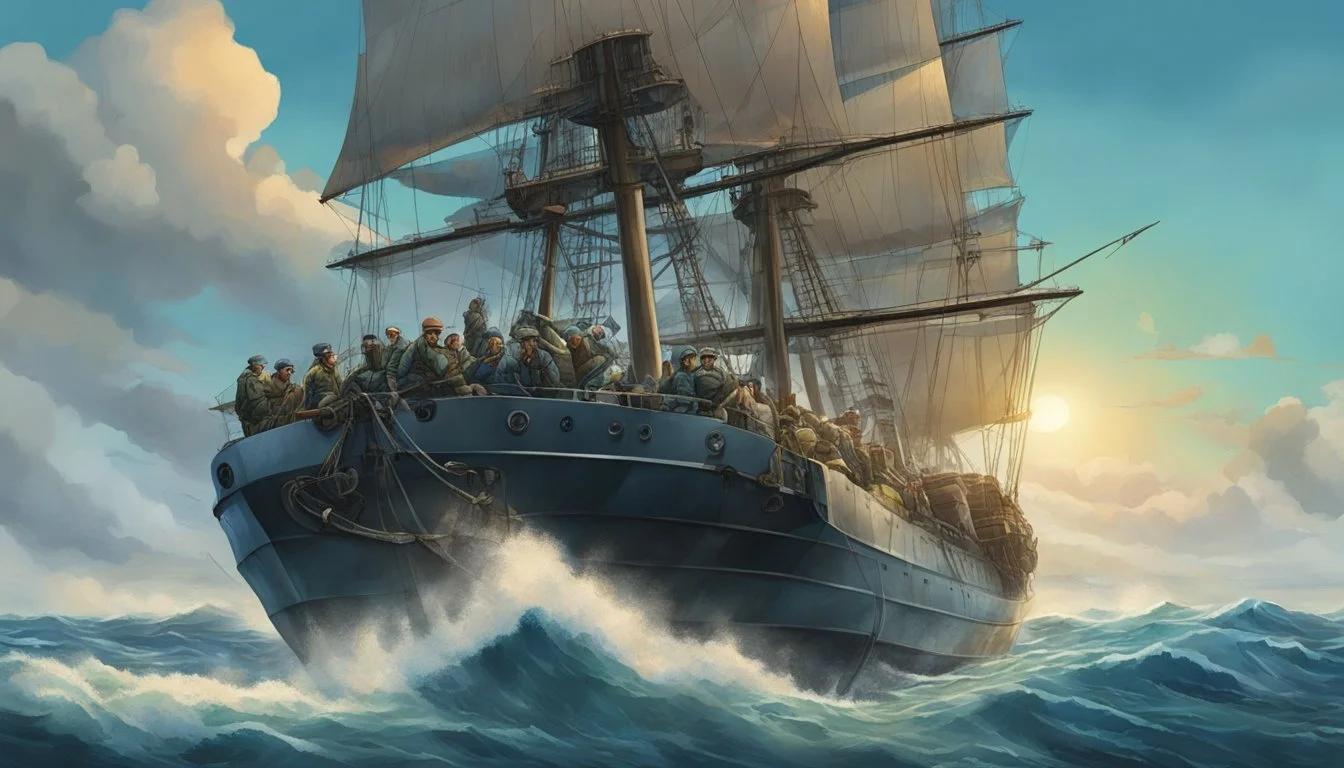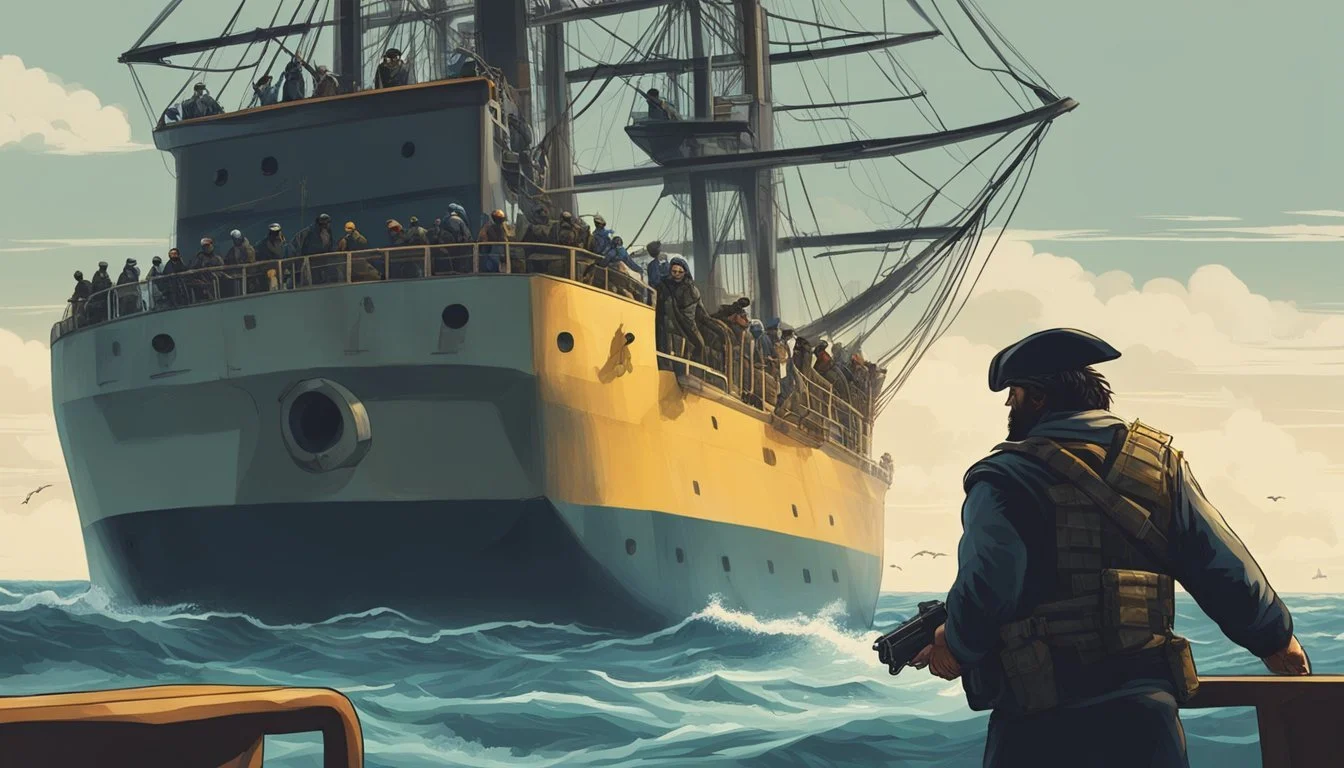High Seas Hijacking: The True Events of 'Captain Phillips'
Somali Pirate Attack Examined
The 2009 hijacking of the Maersk Alabama by Somali pirates thrust Captain Richard Phillips into the international spotlight. This real-life maritime drama unfolded off the coast of Somalia, marking the first time in two centuries that pirates had successfully seized an American cargo ship.
The events of the Maersk Alabama hijacking were later portrayed in the 2013 film "Captain Phillips," starring Tom Hanks, which closely mirrored the actual incident. The movie brought widespread attention to the dangers faced by merchant vessels in pirate-infested waters and the bravery of their crews.
Captain Phillips' own account of the ordeal, co-written with Stephan Talty, was published in 2010 as "A Captain's Duty." This book served as the basis for the film adaptation, offering readers a firsthand perspective on the tense four-day standoff between the ship's crew, their captors, and the U.S. Navy.
Historical Background of Maritime Piracy
Maritime piracy has plagued the seas for centuries, evolving with changing technologies and geopolitical landscapes. The rise of Somali piracy in the early 21st century marked a significant shift in modern maritime security challenges.
Evolution of Somali Piracy
Somali piracy emerged in the 1990s following the collapse of the Somali government. Initially, local fishermen acted as vigilantes against illegal fishing in their waters. This soon transformed into organized criminal activity.
By the early 2000s, Somali pirates had developed sophisticated tactics. They used mother ships to launch smaller attack boats, targeting cargo vessels and oil tankers. The pirates' range expanded from coastal waters to hundreds of miles offshore.
International naval patrols increased in response to the growing threat. However, the vast expanse of the Indian Ocean made it challenging to prevent all attacks. The pirates adapted, using more advanced weapons and communication equipment.
Previous Pirate Attacks
Before the Maersk Alabama incident, Somali pirates had successfully hijacked numerous vessels. In 2008, they captured the Ukrainian cargo ship MV Faina, carrying tanks and weapons. This raised concerns about arms falling into the wrong hands.
The Saudi-owned Sirius Star, seized in November 2008, was the largest ship ever hijacked by pirates. This supertanker's capture demonstrated the pirates' growing ambition and capabilities.
French luxury yacht Le Ponant was taken in April 2008. Its crew was held hostage for a week before being released. This incident highlighted the personal danger faced by sailors in pirate-infested waters.
These attacks led to increased international cooperation. NATO, the EU, and individual nations deployed naval forces to the region. Despite these efforts, piracy remained a significant threat in the waters off Somalia's coast.
The Maersk Alabama Incident
The 2009 hijacking of the Maersk Alabama marked a significant event in modern maritime history. It involved a confrontation between Somali pirates and the crew of an American cargo ship, culminating in a dramatic rescue operation by U.S. Navy forces.
Timeline of the 2009 Hijacking
On April 8, 2009, four Somali pirates boarded the MV Maersk Alabama approximately 240 nautical miles southeast of Eyl, Somalia. The ship's crew of 20 American sailors initially attempted to repel the attackers.
As the pirates searched the vessel, most crew members hid in a secure room. Captain Richard Phillips offered himself as a hostage to protect his crew.
The pirates retreated to a lifeboat with Captain Phillips. A standoff ensued between the pirates and the U.S. Navy, lasting several days.
On April 12, U.S. Navy SEAL snipers took action. They killed three pirates and rescued Captain Phillips, ending the crisis.
Crew Members and Their Roles
Captain Richard Phillips led the Maersk Alabama during the hijacking. His decision to offer himself as a hostage was crucial in protecting his crew.
Chief Engineer Mike Perry played a key role in disabling the ship's engines, preventing the pirates from taking control of the vessel.
Second Officer Shane Murphy took command of the ship after Captain Phillips was taken hostage. He coordinated with U.S. Navy forces during the rescue operation.
The remaining crew members worked together to repel the initial attack and maintain control of the ship. Their quick thinking and teamwork were instrumental in the successful outcome of the incident.
The Real Captain Phillips
Richard Phillips became the center of international attention after his ship was hijacked by Somali pirates in 2009. His actions during the crisis drew both praise and scrutiny.
Richard Phillips' Biography
Richard Phillips was born in 1955 in Winchester, Massachusetts. He graduated from the Massachusetts Maritime Academy in 1979. Phillips spent over 30 years at sea, working his way up to become a merchant mariner and captain.
In 2009, he was serving as captain of the Maersk Alabama container ship. Phillips was married with two children and lived in Vermont when not at sea. His experience and leadership were put to the test during the pirate attack off the coast of Somalia.
His Actions During the Hijack
When Somali pirates boarded the Maersk Alabama on April 8, 2009, Captain Phillips took decisive action. He ordered the crew to hide in a secure room while he remained on the bridge. Phillips attempted to misdirect the pirates and protect his crew.
After a failed escape attempt, Phillips offered himself as a hostage in exchange for the pirates leaving his ship and crew. He spent five days in a lifeboat with the armed hijackers before being rescued by U.S. Navy SEALs.
Phillips' conduct during the ordeal was widely praised. However, some crew members later criticized his decision to sail close to the Somali coast despite piracy warnings.
Piracy Tactics and Countermeasures
Somali pirates employed specific strategies to hijack ships, while international naval forces developed countermeasures to combat these threats. The clash between these tactics shaped maritime security in the region.
Assault Strategies Used by Somali Pirates
Somali pirates utilized small, fast skiffs to approach and board larger vessels. They often carried AK-47s and other weapons to intimidate crews. Pirates targeted ships in busy shipping lanes, exploiting vulnerabilities in less-protected areas.
These attackers used grappling hooks and ladders to climb aboard. Once on deck, they sought to quickly gain control of the bridge and communications. Pirates sometimes employed mother ships to extend their range and sustain longer operations at sea.
Hijackers demanded large ransoms, using hostages as leverage. They maintained control of captured vessels for extended periods while negotiations took place.
Response by International Naval Forces
The U.S. Navy and other international forces increased patrols in high-risk areas. They established recommended transit corridors for merchant vessels, providing better protection.
Naval vessels conducted escort operations for vulnerable ships. When hijackings occurred, specialized teams like Navy SEALs stood ready to intervene.
Forces developed improved surveillance techniques to detect pirate activity. They shared intelligence among allied nations to coordinate responses more effectively.
Navies also worked with commercial shipping companies to implement better onboard security measures. These included hardening ships against boarders and training crews in evasion tactics.
Hostage Situation and Rescue Operation
The hijacking of the Maersk Alabama escalated into a tense hostage crisis at sea. Captain Richard Phillips found himself held captive on a lifeboat by Somali pirates for nearly five days as U.S. Navy forces worked to secure his release.
Lifeboat Hostage Crisis Overview
Captain Phillips was taken hostage aboard one of the Maersk Alabama's lifeboats on April 8, 2009. Four armed Somali pirates held him at gunpoint as they drifted in the Indian Ocean. The 28-foot enclosed lifeboat had limited fuel and supplies.
USS Bainbridge, a Navy destroyer, arrived on scene to monitor the situation. For days, the lifeboat bobbed in shark-infested waters as negotiations continued. Phillips made several escape attempts but was recaptured each time.
The pirates grew increasingly agitated as their options dwindled. They threatened Phillips' life multiple times during the ordeal.
Negotiation and Rescue by Navy SEALs
U.S. officials attempted to negotiate Phillips' release, but talks broke down. As the situation deteriorated, Navy SEAL snipers were deployed to the USS Bainbridge.
On April 12, with Phillips' life in imminent danger, the SEALs took action. Three pirates were visible through the lifeboat's windows. In a coordinated operation, SEAL snipers fired simultaneous shots, killing all three captors instantly.
Navy forces quickly boarded the lifeboat and rescued Phillips unharmed. The fourth pirate had surrendered earlier to seek medical attention aboard the Bainbridge.
This dramatic rescue showcased the skill of Navy SEAL operators and boosted the team's public profile. It later inspired a popular Navy SEAL recruitment film.
Aftermath and Legal Consequences
The 2009 Maersk Alabama hijacking had significant legal and personal repercussions for those involved. Criminal proceedings were initiated against the captured pirates, while some crew members pursued civil action.
Fate of the Pirates and Trials
Abduwali Muse, the sole surviving pirate, faced prosecution in the United States. He was charged with piracy, conspiracy to seize a ship by force, and hostage-taking. In 2011, Muse received a sentence of 33 years and 9 months in federal prison.
The other three pirates were killed during the rescue operation by U.S. Navy SEAL snipers. Their bodies were returned to Somalia for burial.
Muse's trial marked the first piracy case in the U.S. in over a century. It set a precedent for prosecuting maritime piracy in American courts.
Impact on the Crew Members and Lawsuits
Several crew members of the Maersk Alabama filed lawsuits against the shipping company. They claimed the company had ignored warnings about pirate activity in the region. The crew sought compensation for physical and emotional trauma suffered during the hijacking.
Captain Phillips faced criticism from some crew members. They alleged he had disregarded safety protocols by sailing too close to the Somali coast. These accusations led to debates about maritime safety practices in high-risk areas.
The incident prompted shipping companies to reassess security measures. Many vessels began employing armed guards when traversing pirate-prone waters. The event also sparked international efforts to combat piracy off the Somali coast.
Adaptation of True Events into Film
The movie "Captain Phillips" transformed real-life events into a gripping cinematic experience. Director Paul Greengrass and actor Tom Hanks brought authenticity and intensity to the big screen adaptation.
Paul Greengrass and Filmmaking Approach
Paul Greengrass, known for his documentary-style filmmaking, applied his signature techniques to "Captain Phillips." He used handheld cameras and natural lighting to create a sense of realism and immediacy.
Greengrass conducted extensive research, interviewing crew members and studying the actual events. This attention to detail helped maintain accuracy while crafting a compelling narrative.
The director focused on building tension gradually, mirroring the escalating danger of the real hijacking. He balanced action sequences with quieter moments to develop characters and explore themes of globalization and economic disparity.
Casting and Performance of Tom Hanks and Barkhad Abdi
Tom Hanks' portrayal of Captain Richard Phillips was praised for its nuance and emotional depth. He meticulously studied Phillips' mannerisms and accent to deliver an authentic performance.
Hanks conveyed Phillips' calm leadership under pressure, as well as his vulnerability during captivity. His final scenes, depicting shock and trauma, were particularly lauded by critics.
Barkhad Abdi, in his acting debut as pirate leader Muse, delivered a breakout performance. His portrayal humanized the pirates without romanticizing their actions.
The dynamic between Hanks and Abdi drove much of the film's tension. Their on-screen chemistry and conflicting motivations added layers of complexity to the true story.
Cultural Impact and Reception
The hijacking of the Maersk Alabama and subsequent film adaptation sparked widespread public interest and influenced maritime security policies. The incident highlighted the ongoing threat of piracy in international waters.
Public Perception of the Incident and Film
The real-life hijacking drew global attention to Somali piracy. Media coverage portrayed Captain Phillips as a heroic figure who risked his life to protect his crew. The 2013 film starring Tom Hanks reinforced this narrative, receiving critical acclaim and six Academy Award nominations.
Audience reactions were largely positive, praising the film's tense atmosphere and performances. Some viewers criticized the portrayal of Somali pirates as one-dimensional. The movie sparked discussions about the complexities of global inequality and maritime crime.
Influence on Maritime Security Policies
The Maersk Alabama incident prompted a reevaluation of anti-piracy measures. Shipping companies increased security drills and adopted best management practices to deter attacks. Many vessels began employing armed security teams when traversing high-risk areas.
International naval forces expanded their presence in piracy-prone regions. Governments implemented stricter prosecution policies for captured pirates. The incident highlighted the need for better coordination between military and commercial entities in combating maritime terrorism.
These policy changes contributed to a significant decrease in successful pirate attacks in subsequent years. The event remains a case study in maritime security training programs worldwide.
Comparative Analysis with Related Stories
The events of "Captain Phillips" share parallels with other real-life hijackings and fictional portrayals. These similarities and representations offer insights into broader themes of heroism, survival, and maritime security.
Similarities with Other Hijacking Incidents
The Maersk Alabama hijacking bears resemblances to other maritime incidents. Like "Captain Phillips," the hijacking of the Sirius Star in 2008 involved Somali pirates targeting a commercial freighter. Both cases highlighted vulnerabilities in shipping routes off the Horn of Africa.
The quick response of naval forces in the "Captain Phillips" incident mirrors the rescue operation in the 2009 hijacking of the MV Faina. In both situations, international naval cooperation played a crucial role in resolving the crisis.
The psychological impact on crew members in "Captain Phillips" echoes experiences from other hijackings, such as the 2008 Le Ponant yacht incident. Survivors often report feelings of fear, helplessness, and trauma.
Representation in Media and Literature
"Captain Phillips" joins a long tradition of maritime tales in media and literature. The film's portrayal of a determined captain facing danger at sea evokes classic narratives like "Moby-Dick."
Modern works like "A Hijacking" (2012) offer a more subdued take on piracy, focusing on negotiation processes. In contrast, "Captain Phillips" emphasizes action and heroism, similar to films like "United 93" and "Sully."
Documentaries such as "Stolen Seas" (2012) provide factual context to the piracy issue, complementing dramatized accounts. These non-fiction works often delve into the socioeconomic factors driving Somali piracy.
The tension and realism in "Captain Phillips" draw comparisons to the Bourne movies, particularly "The Bourne Supremacy" and "The Bourne Ultimatum." Both feature high-stakes confrontations and resourceful protagonists.







